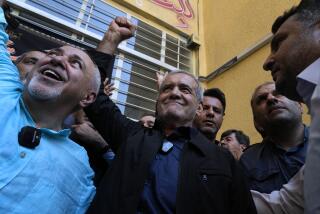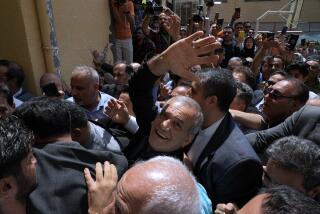Sham in Iran
Today’s topic: Was the Iran presidential election truly fraudulent, or is there any way incumbent Mahmoud Ahmadinejad could have won by a 2-1 margin?
Why would the supreme leader, Ali Khamenei, show his hand like this?
Point: Matthew Duss
I think there are two ways to look at the first part of the question. In the sense that all candidates for president in Iran must be vetted by the Guardian Council -- a group of unelected clerics that rejected hundreds of applicants -- then clearly yes, the elections were fraudulent and would not nearly meet the standard of openness that we enjoy in the United States. This is not to say that “democracy” does not occur in some respects in Iran, or that the peoples’ voices are not heard. It does, and they are, albeit in a relatively narrow space.
But even recognizing the tight constraints within which democracy exists in Iran, it’s hard to take seriously the idea that controversial incumbent Mahmoud Ahmadinejad could get 63% of the Iranian vote, taking 24.5 million votes to leading challenger Mir-Hossein Mousavi’s 13.2 million. We can, of course, not know for sure, but we can take note of a few things that give off a distinct whiff of shenanigans.
The first is that Iranian Supreme Leader Ayatollah Ali Khamenei, who had previously made very clear that he supported Ahmadinejad’s reelection, appeared on television to hail the incumbent’s victory soon after polls had closed. As Middle East scholar Juan Cole pointed out, “the Electoral Commission is supposed to wait three days before certifying the results of the election, at which point they are to inform Khamenei of the results, and he signs off on the process. ... In this case, Khamenei immediately approved the alleged results.”
As BBC Iranian affairs analyst Sadeq Saba noted, in past elections, as votes were counted, the results were announced province by province. In this election, “the results came in blocks of millions of votes -- in percentages of the vote,” with little variance in the vote distribution. Saba noted that this suggested that Ahmadinejad did equally well in rural and urban areas; the voluble populist has consistently enjoyed far greater support in rural areas than in cities (though there was recent evidence that even his rural support was waning).
Another puzzle is that Mousavi, an ethnic Azeri Turk, was beaten by Ahmadinejad in Mousavi’s home province of Azerbaijan. As Karim Sadjadpour of the Carnegie Endowment for International Peace put it, , “This is the equivalent of Barack Obama losing the African American vote to John McCain in 2008.”
As to the second part of the question, there is a way that Ahmadinejad could have won by a 2-1 margin: If reformers had stayed home and didn’t vote. That didn’t happen. There was record turnout, which the supreme leader himself recognized in his televised address as “a real feast.”
The more interesting question to me, then, is why. Why would Khamenei, who has until now been more subtle and meticulous in exercising his control over the Iranian government, show his hand like this? Popular consent has played a small yet significant part in maintaining the legitimacy of the Iranian system, so why have Khamenei and his cohorts apparently decided to dispense with it now?
Matthew Duss is a national security researcher and writer at the Center for American Progress.
Khamenei couldn’t tolerate another pro-reform president.
Counterpoint: Michael Rubin
There is no such thing as a free election in the Islamic Republic. The religious regime seeks the legitimacy of democracy but not the idea of subordinating leadership to popular will. The supreme leader and the Guardian Council carefully monitor campaigns and massage the process. This year, as you mention, Matt, the Guardian Council eliminated more than 99% of the candidates who sought to run for president. It is easy to falsify the results at any stage: The Iranian government forbids independent monitoring. In the 2005 election, Mohammad Bagher Ghalibaf, who led exit polling, claimed fraud after he went to sleep in first place and woke up in third.
You imply that Western analysts underestimate incumbent Ahmadinejad, and I agree. Western journalists and academics hang out in the bookstores around Tehran University and the cafes of northern Tehran where Iranians embrace the reformist tendencies voiced by Mousavi. But, in the projects of western Tehran and the slums of the south, Ahmadinejad’s demagoguery is attractive. Many Iranians resent both the fabulous wealth accumulated by the Islamic Republic’s elite and their nepotism. This is why, in the last days of the campaign, Ahmadinejad made former President Ali Akbar Hashemi Rafsanjani (perhaps the richest man in Iran) and his extended family the target of his attacks. Iranians juxtapose Rafsanjani’s luxuries with Ahmadinejad’s ascetic lifestyle. Finally, while the campaign officially was just three weeks long, Ahmadinejad campaigned for four years, spending more time in provincial towns and villages than any of his predecessors.
That said, the numbers don’t pass the smell test. The Interior Ministry reported turnout greater than 99% in some provinces. While such numbers are unlikely, both consensus inside Iran and anecdotal accounts from election day suggest that high turnout would benefit Mousavi. As you said, Matt, it seems strange that Ahmadinejad would beat Mousavi in east Azerbaijan (even though Mousavi squeaked by in west Azerbaijan). Or that Ahmadinejad would win former President Mohammad Khatami’s home province of Yazd after Khatami campaigned so heavily for the challenger.
Matt, you put your finger on the right question: Why would Supreme Leader Khamenei show his hand like this? Let me take a crack at that.
Remember, in the Islamic Republic, sovereignty comes from God; it doesn’t matter what the majority of people think. Khamenei became supreme leader after Ayatollah Ruhollah Khomeini’s death in 1989. Khamenei was a compromise candidate. He didn’t have Khomeini’s charisma or religious credentials. Khamenei ruled by balancing factions. Whenever any politician would get too powerful, Khamenei would cut that person down to size. It hasn’t always worked. In 1997, reformer Khatami won a surprise victory against the supreme leader’s favorite candidate. Khamenei later regretted letting the results stand after Khatami unleashed passions that threatened regime stability. Indeed, next month marks the 10th anniversary of the student uprising in 1999, which I witnessed firsthand in Iran. When the Guardian Council approved the soft-spoken Mousavi’s candidacy, no one expected his message to resonate. But when it caught on, Khamenei decided to nip the problem in the bud. The next couple days will show whether he was successful.
Michael Rubin is a resident scholar at the American Enterprise Institute and a senior lecturer at the Naval Postgraduate School.
More to Read
A cure for the common opinion
Get thought-provoking perspectives with our weekly newsletter.
You may occasionally receive promotional content from the Los Angeles Times.










